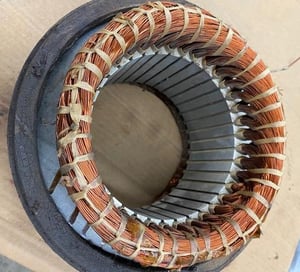When you buy an electric motor, what is often unseen when handling it is  the work that goes into helping extend its life by securing the end coils of windings. This process is called stator lacing. Tightly lacing the coils adds stability and helps protect the windings from vibration, which can cause fatigue and shorten a motor’s life. It also holds electronic, thermal, and other sensory devices in place during the dipping and baking process.
the work that goes into helping extend its life by securing the end coils of windings. This process is called stator lacing. Tightly lacing the coils adds stability and helps protect the windings from vibration, which can cause fatigue and shorten a motor’s life. It also holds electronic, thermal, and other sensory devices in place during the dipping and baking process.
Service Thread’s round lacing cords are available in polyester, nylon, and para-aramid materials such as DuPont™ Kevlar® material. These are cabled constructions, typically three or sometimes four-ply, which offer a round cross-section. Round twisted sizes in nylon and polyester cords can range from number 138 to 690 (tex 135 to 700), offering minimum breaking strengths in the range of 18 to 100 pounds.
However, most common round twisted sizes are number 346 (tex 350), number 415 (tex 400), number 554 (tex 600), and number 690 (tex 700), which offer minimum breaking strengths in the range of 45 to 100 pounds. Round twisted lacing cords number 138 to 690 (tex 135 to 700) will have a diameter between about .01 to .05 inches, while the diameter of most common lacing cords will be .035 inches plus or minus about 15%.
Flat number 554 (tex 600) nylon lacing tape is also a popular choice. Being wider than round twisted thread, it will spread the stress over the coil surface during winding and tying rather than having it located at a small radius. Flat tape also offers increased grip due to its larger surface area.
Round thread can be laced evenly from large supply packages of more than or equal to 10 pounds. Flat constructions are typically rolled to prevent any twisting of the tape. Round twisted lacing cords are much preferred over cable ties, which turn brittle over time through oxidation and break and leave sharp edges which can cut installers’ hands when reaching into confined spaces.
Lacing cords may have some physical requirements, depending on the motor design and coil assembly.
These may include:
- Medium to high dry heat shrinkage (DHS) of about 8 to 13% after one hour at 350⁰F, referred to as shrinkable
- Low DHS less than or equal to 3% after one hour at 350⁰F, sometimes referred to as pre-shrunk
- Soft with no finish, or uncoated
- Bonded, or coated
- Waxed
- Heat resistant, which means it can withstand application temperatures up to 180⁰C, covering most National Electrical Manufacturers’ Association (NEMA) insulation temperature ratings
Pre-shrunk polyester is preferred for fine wire or soft insulation systems where undesirable high tensions are created due to shrinkage during the baking process. All can be coated or uncoated. Common coatings/treatments are polyurethane, nylon, or wax, all of which offer abrasion resistance and good knot retention.
For assistance with choosing the right round twisted or flat lacing tape for the job, coated or uncoated, contact Service Thread.



